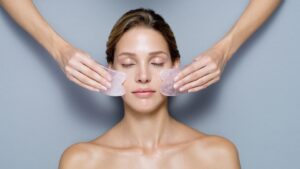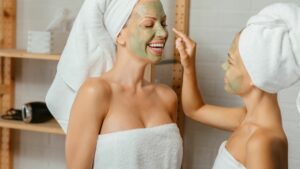Glow for the skin – what is it actually?

Actually, you can no longer hear the word glow. Hardly any cosmetics manufacturer does not have at least one product in its range that promises glow for the skin. The beauty pages of women’s magazines outdo each other with recommendations for a “glowy” or “dewy” complexion. For men, by the way, glow is never to be mentioned; there, glow tends to be equated with oily. But what actually makes this mysterious glow of the female skin?
Glow means as much as radiate or shine. The term has a positive connotation because it means softly glowing skin that looks as if an Insta-filter has been placed over it. A baby’s skin naturally possesses it. Even in youth, this rosy freshness is still present because the skin is well supplied with blood and has enough elasticity. Unfortunately, this natural glow diminishes with age, when environmental damage affects the skin and it is already thinner and less even due to wrinkles and pigment spots. It becomes visibly paler and loses its radiant appearance. What you got from nature when you were young, you need to work on it later.
Perfect skin does not exist
Don’t be embarrassed if your skin isn’t absolutely flawless. It only exists on TikTok, Instagram and Pinterest anyway, thanks to filters and light corrections. True, social media would have us believe that hair, pimple and pore-free skin is the norm and everything else is somehow „wrong“ with it. But that’s absolute nonsense!
“When people talk about ‘radiant skin,’ they usually mean an even complexion without spots – a smooth surface that reflects light in a flattering way,” confirms London dermatologist Dr. Justine Kluk. It’s a misconception that only glowing skin is healthy, and if it’s not, you’re doing something wrong. Although you eat healthy, get enough sleep, moisturize your skin, wear sunscreen, don’t smoke, and all of these can obviously be better for your body and your skin, ‘glow’ is not a reliable indicator of your health,” Dr. Kluk says. Even if someone has acne or rosacea, they may basically be a healthy person.
Step by step
This is not to say that you can’t improve the appearance of your skin. But you should not try to achieve everything at once, but always set yourself only one goal. Otherwise, you could overtax your skin. It’s best to keep your routine as simple as possible and approach the goal you set step by step. Determine what should be top priority. If you’re bothered by hyperpigmentation, reach for glycolic acid. For acne, use salicylic acid. If there are improvements, then you can move on to the next target.
Cold treatments, for example, are a perfect booster for microcirculation. They firm the skin, even out fine lines, tighten pores and improve radiance. There are special cryo-masks or so-called Ice Globes for this purpose. These are liquid-filled spheres on a handle that you put in the refrigerator before use and then massage your face with.
Apply in the morning or evening with light pressure on the forehead, the area under the eyes, cheeks, jaw and neck. Nothing comes from nothing: you have to spend 20 minutes each time. British model icon Kate Moss is particularly brave. She swears by an ice-cold dipping trick for her face: “Fill a basin with ice cubes, cold water and cucumber slices and soak your face in it for as long as you can stand it.”
Massages and pillow changes
Australian acupuncturist, aromatherapist and skin expert Annee de Mamiel recommends facial massages. “With each stroke, they make the skin glow more,” she says. “The movements increase circulation and allow blood to flow into the cells with all its components, such as oxygen, vitamins and minerals, while draining congested lymph and toxins. At the same time, muscular tension is relieved and tone and volume are built.”
The daily massage with a Gua Sha stone made of rose quartz also has a firming, regenerating and circulatory effect. First pull it along the jaw line to the right and left of the chin. Then stroke the cheeks in the direction of the ear and finally the wrinkles around the eyes in the direction of the temples. Massage each area with the stone at least ten times.
If you constantly have problems with impurities, you should change your pillowcase at least once a week to banish bacteria and dust mites from it. Also wash the pillow itself regularly. In case of inflammatory reactions, i.e. redness, the detergent may also be the cause. Use a mild, fragrance-free product. Silk pillows are best for the skin because they have a smooth surface, breathable and cooling.
Peeling brings glow
Regular peels are considered the best glowbringers because they remove dead cells from the top layer of skin, revealing a more radiant surface underneath. Popular substances for peelings include fruit acids (AHA), beta hydroxy acids (BHA) such as salicylic acid, and polyhydroxy acids (PHA) such as lactic acid. In addition, mild acid peels ensure finer pores and smoother skin.
Munich dermatologist Dr. Miriam Rehbein denies that it is possible to exfoliate too much: “What you remove are only the dead horny cells, you cannot remove the skin itself.” What she advises against, however, are homemade mixtures of oil and salt, as they are often suggested as home remedies. “The salt crystals are too edged, they could injure the skin,” she says. To cleanse oily or acne-prone skin afterwards, use a toner that also contains salicylic acid, which removes the last sebum residues and brings the skin into balance.
Apply cream to the still damp skin
If you want to get the most out of your skin care products, there is a simple trick: apply cream to skin that is still damp. It should not be wet, but dabbed dry with a towel. The idea behind this is that skin that is still “steamy” is superficially moisturized and more permeable to active ingredients. A humectant, i.e. a hygroscopic substance such as hyaluronic acid and glycerin, has to make less of an effort to bind the moisture in the skin.
This tip is especially recommended for a weak skin barrier, as is the case with dermatitis or eczema. Vitamin A-based products (vitamin A derivatives such as retinoids and retinol) can contribute a lot to a radiant complexion. They accelerate cell renewal, activate the body’s collagen production and improve skin texture by smoothing fine lines and minimizing pores.
Photo: Gua Sha @babor

CultureAndCream Author from Munich
To travel during my profession as a beauty journalist was never enough for my. Also my six month on a world trip didn’t do it. It always attracts me to other cities, foreign countries, on roadtrips and places I don’t know yet. But I am not only interested in “culture” and “cream”, I am also fascinated by people who have stories to tell . Such unique experiences I want to share with you.



